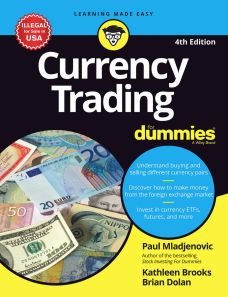Currency Trading For Dummies, 4ed
ISBN: 9789357460491
416 pages
Publication Year: 2023
For more information write to us at: acadmktg@wiley.com

Description
Currency Trading For Dummies 4th Edition is the need-to-read guide for financial gurus looking to expand their knowledge into the foreign exchange market. Prospective traders will learn the difference between the stock market and the foreign exchange market, the foundations of currency trading, and secrets to success.
Introduction
About This Book
Foolish Assumptions
Icons Used in This Book
Beyond the Book
Where to Go from Here
Part 1: Getting Started with Currency Trading
Chapter 1: Currency Trading 101
- What Is Currency Trading?
- Speculating as an enterprise
- Currencies as the trading vehicle
- What Affects Currency Rates?
- Fundamentals drive the currency market
- But sometimes it's the technicals that are driving
- the currency market
- Or something else may be a driving force
- Developing a Trading Plan
- Finding your trading style
- Planning the trade
- Executing the Trading Plan from Start to Finish
Chapter 2: What Is the Forex Market?
- Getting Inside the Numbers
- Trading for spot
- Speculating in the currency market
- Getting liquid without getting soaked
- Around the World in a Trading Day
- The opening of the trading week
- Trading in the Asia-Pacific session
- Trading in the European/London session
- Trading in the North American session
- Key daily times and events
- The U.S dollar index
- Looking at Currencies and Other Financial Markets
- Gold
- Oil
- Stocks
- Bonds
- Getting Started with a Practice Account
Chapter 3: Who Trades Currencies? Meet the Players
- The Interbank Market Is "the Market"
- Getting inside the interbank market
- Bank to bank and beyond
- Hedgers and Financial Investors
- Hedging your bets
- Global investment flows
- Speculators: Running the Forex Show
- Hedge funds
- Day traders

